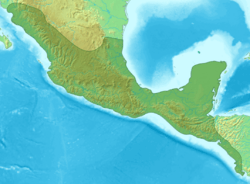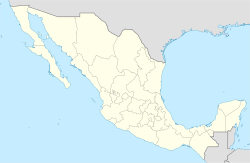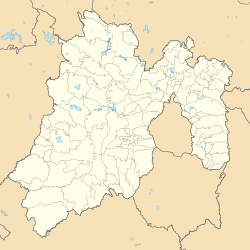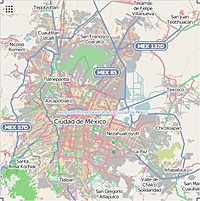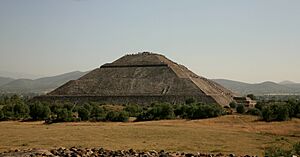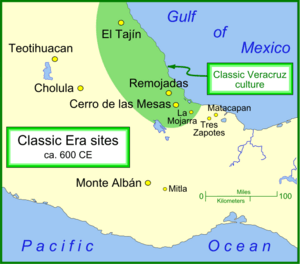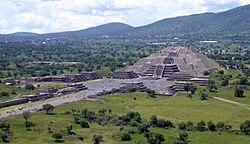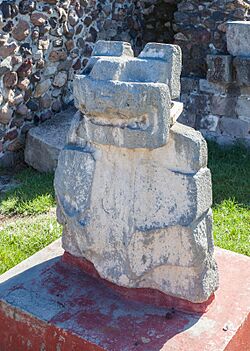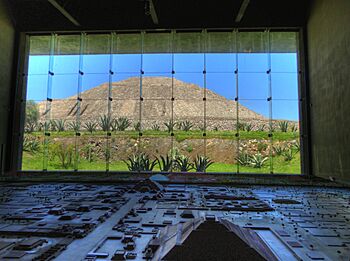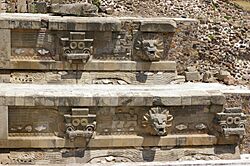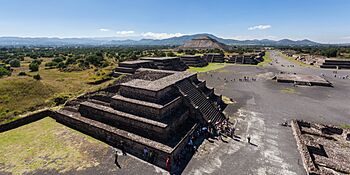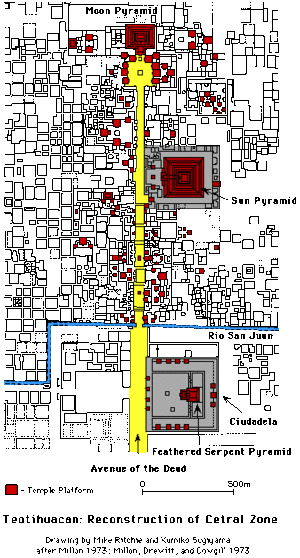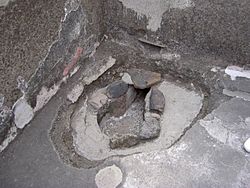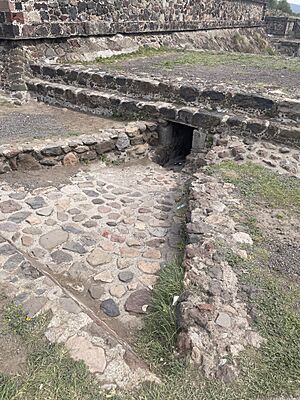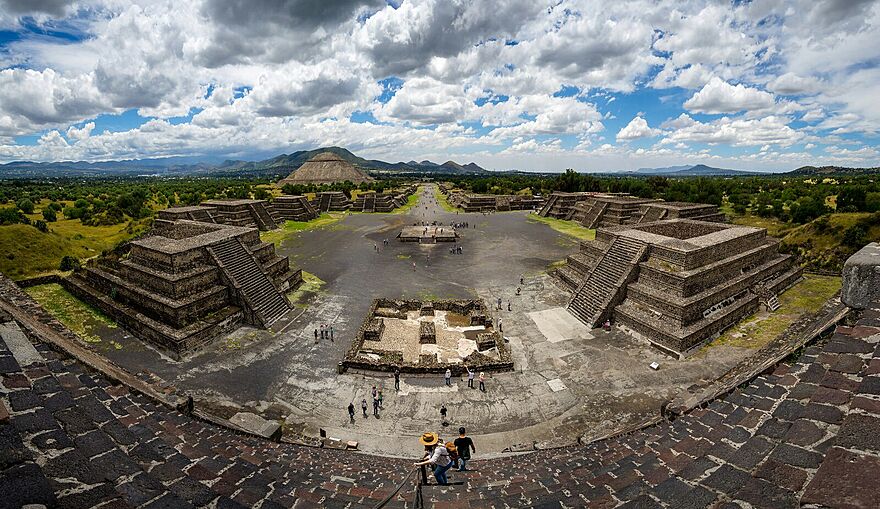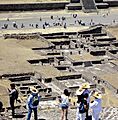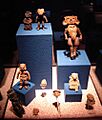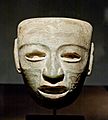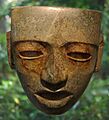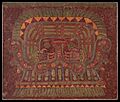Teotihuacan facts for kids

View of the Avenue of the Dead and the Pyramid of the Moon.
|
|
| Location | Teotihuacán, State of Mexico, Mexico |
|---|---|
| Coordinates | 19°41′33″N 98°50′38″W / 19.69250°N 98.84389°W |
| History | |
| Periods | Late Preclassic to late Classic |
| Site notes | |
| Architecture | |
| Architectural styles | Talud-tablero |
| UNESCO World Heritage Site | |
| Official name | Pre-Hispanic City of Teotihuacan |
| Criteria | Cultural: i, ii, iii, iv, vi |
| Inscription | 1987 (11th Session) |
| Area | 3,381.71 ha |
Teotihuacan (pronounced tay-oh-tee-wah-KAHN) is an amazing ancient city in Mesoamerica. It's located in a valley in the State of Mexico, about 40 kilometers (25 miles) northeast of modern Mexico City.
Today, Teotihuacan is famous for its huge Mesoamerican pyramids. The most well-known are the Pyramid of the Sun and the Pyramid of the Moon. Even though it's near Mexico City, Teotihuacan was not an Aztec city. It was built many centuries before the Aztecs existed.
At its busiest, around 1 CE to 500 CE, Teotihuacan was the biggest city in the Americas. It had at least 25,000 people, and some think it might have had 125,000 or more. This made it one of the largest cities in the world at that time.
The city covered about 20 square kilometers (8 square miles). Most people in the valley lived in Teotihuacan. Besides the pyramids, the city is known for its large apartment buildings, the main road called the Avenue of the Dead, and colorful murals. Teotihuacan also made and traded excellent obsidian tools across Mesoamerica.
The city likely started around 100 BCE. Its biggest buildings were constructed until about 250 CE. Teotihuacan might have lasted until the 7th or 8th centuries CE. However, its main buildings were damaged and burned around 550 CE. This decline might have been linked to very bad weather around 535–536 CE.
Teotihuacan began as a religious center in Mexico around the 1st century CE. It grew to be the largest and most populated city in the Americas before Christopher Columbus arrived. The city had multi-story apartment buildings for its many residents. The name Teotihuacan also refers to the entire culture and civilization connected to this site.
Teotihuacan had a huge impact across Mesoamerica. Its influence is seen at many sites in other regions. Later, the Aztecs admired these ruins. They believed they shared a history with the Teotihuacanos and copied parts of their culture. We don't know for sure what ethnic groups lived in Teotihuacan. Some ideas include the Nahua, Otomi, or Totonac people. Others think it was a multi-ethnic city, with people from Maya and other groups. Many different cultures lived in Teotihuacan when it was at its strongest.
After Teotihuacan declined, other cities like Xochicalco and Tula became important in central Mexico.
The ancient city is now in the San Juan Teotihuacán area of the State of México. It's about 40 kilometers (25 miles) northeast of Mexico City. The site covers 83 square kilometers (32 square miles). UNESCO named it a World Heritage Site in 1987. In 2024, it was the second most-visited ancient site in Mexico.
Contents
What's in a Name?
The name Teotihuacan was given by the Nahuatl-speaking Aztecs. They named it centuries after the city fell around 550 CE. The name means "birthplace of the gods" or "place where gods were born." This reflects Aztec stories about how the gods created the universe there. One scholar, Thelma D. Sullivan, thinks it means "place of those who have the road of the gods."
We don't know the city's original name. But in ancient Maya writings, it appears as "puh," meaning "Place of Reeds." This suggests the Maya saw Teotihuacan as a "Place of Reeds," like other big cities of that time.
Recently, experts have looked closely at the name "Teotihuacan." Some believe the Spanish changed the name in the 16th century. Archaeologist Verónica Ortega suggests the city was actually called "Teohuacan." This would mean "City of the Sun," instead of "City of the Gods."
History of Teotihuacan
Early Beginnings

People first settled in the Teotihuacan area around 600 BCE. Until 200 BCE, it was a collection of small villages. About 6,000 people lived in the Teotihuacan Valley then. From 100 BCE to 750 CE, Teotihuacan grew into a huge city. It became an important center with cultural influence across Mesoamerica.
The city's history can be divided into four main periods:
- Period I (200 – 1 BCE): This was when Teotihuacan started to become a city. Farmers began to gather around the many springs in the area.
- Period II (1 CE to 350 CE): Teotihuacan grew very quickly. It became the largest city in Mesoamerica. This growth happened partly because other settlements were destroyed by volcanoes. New people moved in, and the city built its unique apartment complexes. During this time, the famous Pyramids of the Sun and Moon were built.
- Period III (350 to 650 CE): This was Teotihuacan's golden age. The city had at least 125,000 people and was one of the biggest in the ancient world. About half the people in the Valley of Mexico lived here. Many buildings were rebuilt, and beautiful funeral masks were made from green stone.
- Period IV (650 to 750 CE): This period marked the end of Teotihuacan's power. Many elite homes were burned. Archaeologists think this might have been due to fighting within the city. Other reasons for its decline include problems with trade and power struggles. After this, people still lived there, but the city was never as big or powerful again.
How the City Started
The early history of Teotihuacan is a bit of a mystery. We don't know for sure who its first builders were. Around 300 BCE, people in central and southeastern Mesoamerica started forming larger settlements. Teotihuacan was the biggest city in Mesoamerica before the Aztecs, nearly 1,000 years earlier. By the time the Aztecs arrived, the city was already in ruins.
For a long time, people thought the Toltecs built Teotihuacan. This idea came from old writings. However, the word "Toltec" often meant "skilled craftsperson." The Toltec civilization we know flourished much later. So, they couldn't have been Teotihuacan's first builders.
Some scholars believe that a volcano called Xitle erupted. This might have caused many people to move from other areas to the Teotihuacan valley. These new settlers could have helped the city grow quickly.
Other experts suggest that the Totonac people founded Teotihuacan. They also think Teotihuacan was a multi-ethnic state. This means many different groups lived there, like the Zapotec, Mixtec, and Maya peoples. The builders of Teotihuacan were smart about using the land. They built raised garden beds called chinampas in swampy areas. This allowed them to grow a lot of food, even with old farming methods. These channels also helped transport food by canoe. The first buildings in Teotihuacan date back to about 200 BCE. The huge Pyramid of the Sun was finished by 100 CE.
Teotihuacan's Influence on Other Cities
It's interesting that we don't find much evidence of a single king or ruler in Teotihuacan. Other cities at the time, like Maya and Zapotec ones, had royal palaces and carvings of rulers. But Teotihuacan doesn't have these. Many scholars think Teotihuacan was run by a group of leaders, not just one person.
In 378 CE, a warlord named Sihyaj K'ahk' (meaning "born of fire" in Maya) conquered Tikal. Tikal was a Maya city about 965 kilometers (600 miles) away. This warlord was linked to Teotihuacan culture. He removed the Maya king and put a new one in place. This shows Teotihuacan's power reached far.
In 426 CE, a new ruling family started in Copán, a city in modern-day Honduras. The first king was K'inich Yax K'uk' Mo'. He then helped install a new king in Quiriguá, another Maya city.
The City's Peak
The city was at its strongest around 450 CE. It was the center of a powerful culture that influenced much of Mesoamerica. At this time, the city covered over 30 square kilometers (11.5 square miles). It may have had 150,000 to 250,000 people. Different parts of the city housed people from all over the region, even as far south as Guatemala. It's notable that the city doesn't have many forts or military buildings.
Teotihuacan had a big impact on the Maya region. Its building styles, especially one called talud-tablero, were copied in many distant places. This style uses a sloping wall (talud) topped by a rectangular panel (tablero). This shows how far Teotihuacan's ideas spread. When the city was at its peak, its main buildings, including the pyramids, were painted bright dark red. Some small spots of this paint can still be seen today.
Teotihuacan was also a center for making things. Many potters, jewelers, and craftspeople lived there. They were especially known for making many obsidian tools. We don't have any written texts from the ancient Teotihuacanos. However, writings from Maya cities show that Teotihuacan's important people traveled to, and perhaps even conquered, rulers in places like Honduras. Maya writings mention a ruler called "Spearthrower Owl." He was likely a Teotihuacan ruler who reigned for over 60 years. He placed his relatives as rulers in Maya cities like Tikal and Uaxactun.
The art of Teotihuacan, especially its murals, was amazing. The city's painters were some of the best in Mesoamerica. They created tens of thousands of murals between 450 and 650 CE. These murals often showed priests, jaguars, a storm god, and a goddess offering gifts. They focused on nature and gods, rather than showing specific rulers.
The City's Decline
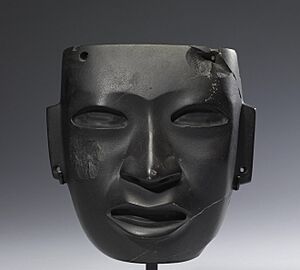
At first, scholars thought invaders attacked and burned Teotihuacan in the 7th or 8th century. But newer evidence suggests the burning was mostly limited to the homes and buildings of the ruling class. This makes some think the fires were caused by an uprising from within the city. Early archaeologists mainly studied palaces and temples, which belonged to the upper classes. Since these places showed burning, they thought the whole city was destroyed. Now, we know the damage was focused on major public buildings along the Avenue of the Dead. There are no signs of a foreign invasion.
The number of people in Teotihuacan started to drop around the 6th century. This supports the idea of internal problems. The city's decline might also be linked to long periods of drought. These droughts were part of the climate changes of 535–536, possibly caused by a volcano eruption in El Salvador. This idea is supported by finding more skeletons of young people with signs of malnutrition from the 6th century. This suggests famine could have been a reason for Teotihuacan's decline. If climate change hurt crop yields, there wouldn't have been enough food for everyone. It's possible that both drought and internal unrest contributed to the city's fall.
As Teotihuacan lost its power, other nearby cities like Cholula, Xochicalco, and Cacaxtla grew stronger. They might have even worked together against Teotihuacan. The art and buildings in these new centers copied Teotihuacan's style but also mixed in ideas from other parts of Mesoamerica.
The sudden destruction of Teotihuacan was not unusual for cities in Mesoamerica. Many Maya cities faced similar fates later on.
Aztec Period
Around the 1200s CE, Nahua people moved into the area and repopulated it. By the 1300s, the area was part of another kingdom. Later, in 1418, the powerful Azcapotzalco kingdom invaded. Eventually, in 1427, the Aztec Empire formed, and Teotihuacan became part of their lands.
Life in Teotihuacan

Archaeological findings show that Teotihuacan was a city with many different ethnic groups. We don't know the main language spoken there. However, early forms of Totonac and Nahuatl are good guesses. This mix of people might have happened after a natural disaster.
Before Teotihuacan grew, another city called Cuicuilco was its rival. Both were similar in size and important for trade. Around 100 BCE, the Mount Xitle volcano erupted. It badly affected Cuicuilco and its farms. Many people from Cuicuilco likely moved to Teotihuacan, causing its population to grow quickly. Another volcano, Popocatepetl, had erupted even earlier. This might have already started to damage farms and buildings. Xitle's eruption then led to Cuicuilco being abandoned.
During the Tzacualli phase (about 1–150 CE), Teotihuacan's population grew to 60,000 to 80,000 people. Most of these new residents came from the Mexican basin. After this, the number of new people slowed down. By about 200 CE, the city's population reached its highest point.
Some experts think an important group in Teotihuacan spoke Totonacan or Mixe–Zoquean languages. Others believe the largest group was Otomi. This is because the Otomi language was spoken in the area before and after Teotihuacan's main period.
Teotihuacan's homes show that people were divided into three groups: high-ranking, middle-ranking, and working-class. The fancier homes were often decorated with detailed murals. These murals showed priests, jaguars, a storm god, and a goddess. They focused on gods and nature, not on specific rulers. This suggests their art celebrated shared values rather than individual leaders. There is also little writing in Teotihuacan art, even though they were in contact with the Maya, who used writing.
The working classes included farmers, skilled craftspeople, and people from nearby rural areas. Craftspeople lived in apartment complexes throughout the city. These centers were important for the city's economy and culture. They made goods like textiles, pottery, and paintings. These neighborhood centers often had physical barriers separating them. This created a kind of internal competition that helped the city's economy.
Archaeologists have studied skeletons to learn about daily life. Some people had worn teeth, suggesting they worked with fibers, perhaps making nets. Female skeletons showed wear on joints, indicating they might have sewn, painted, or carried heavy objects. The city imported many materials, like pottery, marble, and slate. Rural people lived in smaller areas between middle-class homes or on the city's edges. Merchants also had their own camps.
Religion and Beliefs

Scholars have identified several gods worshipped in Teotihuacan. These include:
- The Storm God
- The Great Goddess
- The Feathered Serpent, a very important god linked to the Feathered Serpent Pyramid.
- The Old God
- The War Serpent
- The Netted Jaguar
- The Pulque God
- The Fat God
- The Flayed God
Most scholars agree that the main god of Teotihuacan was the Great Goddess. The city's large pyramids were important religious buildings. Religion and government were closely linked, with religious leaders often being political leaders. These leaders would ask artists to create religious art for ceremonies. This art included murals and special incense burners called censers. Censers were lit during rituals to honor the gods.
Archaeologists have found human and animal remains in the pyramids. This shows that the Teotihuacanos practiced human sacrifice. They likely offered human sacrifices when new buildings were started or expanded. The victims were probably enemy warriors captured in battle. These sacrifices were meant to help the city thrive. Some victims were beheaded, some had their hearts removed, and others were buried alive. Sacred animals like cougars, wolves, eagles, and snakes were also buried alive or kept in cages for rituals.
Many stone masks have been found in Teotihuacan. People used to think these were for funerals. However, some scholars now question this, as the masks don't always seem to come from burials.
Population Growth
Teotihuacan had one of the largest populations in the Valley of Mexico. It grew very quickly and stayed large for most of its existence. Around 100 CE, the population was about 60,000–80,000 people. After 200 years, it stabilized at around 100,000 people by 300 CE.
The population reached its highest point between 400 and 500 CE. During this time, it's estimated there were 100,000 to 200,000 people. This number is based on estimates of how many people could live in the city's 2,000 apartment complexes. These high numbers continued until the city started to decline between 600 and 700 CE.
One neighborhood, Teopancazco, shows that Teotihuacan was a multi-ethnic city. It had areas for different ethnic groups and workers. This neighborhood also had a high rate of infant deaths. This suggests that the city's population grew more from people moving in than from births. People came from surrounding areas, bringing different cultures to the city.
Archaeologists have used special tests on bones and teeth. These tests can tell if someone grew up in Teotihuacan or moved there. This helped them understand the different ethnic neighborhoods.
One neighborhood, Tlailotlacan, was likely home to migrants from the Oaxaca region. Excavations there found artifacts and burial styles from the Zapotec culture. The tests showed that many people in this neighborhood had moved from Oaxaca. They also found evidence that people traveled back to Oaxaca. This helped them keep their culture alive for future generations.
Another neighborhood was called Barrio de Los Comerciantes, or the Merchants' Barrio. This area had different architecture, like round adobe buildings. It also had pottery and artifacts from the Gulf Coast region. Tests showed that many people here had also moved to Teotihuacan and lived there for a long time.
Writing and Art
Archaeologists found over 30 signs and symbols on a patio floor in the La Ventilla district. Many findings suggest that the people of Teotihuacan had their own style of writing. These symbols were made quickly and skillfully, showing they were well-practiced. Other societies around Teotihuacan adopted some of these symbols. However, the Teotihuacanos rarely used symbols or art from other cultures. Their writing system was unique, but they must have known about other writing systems.
Obsidian Workshops
Working with obsidian was a very important skill and a main source of wealth for Teotihuacan. Obsidian is a sharp, volcanic glass. Workshops in the city made many tools and objects from black and gray obsidian. These items were traded far beyond Teotihuacan, to cities like Monte Alban in Oaxaca and Tikal in Guatemala. They made figurines, blades, arrowheads, knives, jewelry, masks, and ornaments.
The obsidian mainly came from mines in Pachuca. Making obsidian tools was the most important industry in Teotihuacan. The city had a monopoly on the obsidian trade in the wider Mesoamerican region. The government closely watched the trade and creation of these tools. This brittle but strong rock was mostly shaped by flaking off pieces from a larger cone. Tools made of wood and bone were also used in the process.
The Ancient Site Today
People never completely forgot about the huge ruins of Teotihuacan. After the city fell, some people continued to live there. During Aztec times, the city was a pilgrimage site. It was linked to the myth of Tollan, where the sun was believed to have been created. Today, Teotihuacan is one of Mexico's most famous ancient attractions.
Discoveries and Research
In the late 1600s, Carlos de Sigüenza y Góngora did some digging around the Pyramid of the Sun. More small excavations happened in the 1800s. In 1905, Mexican archaeologist Leopoldo Batres led a big project to dig up and restore the site. The Pyramid of the Sun was restored for Mexico's 1910 independence celebration. Teotihuacan was the first site in Mexico to be taken over by the government for national heritage. Farmers who worked on the land were asked to leave and were paid some money. A train line was built in 1908 to help move materials and bring tourists.
More digging happened in the 1920s and later decades. From 1960 to 1965, a big project cleared the Avenue of the Dead and restored buildings. During a "sound and light" show setup in 1971, workers found a tunnel and cave system under the Pyramid of the Sun. At first, people thought it was natural, but now we know it was man-made. The inside of the Pyramid of the Sun has not been fully explored.
From 1980 to 1982, another major project worked on the Pyramid of the Feathered Serpent. More recently, excavations at the Pyramid of the Moon have revealed a lot about ancient cultural practices.
New Finds
In late 2003, a tunnel was accidentally found under the Temple of the Feathered Serpent. Archaeologist Sergio Gómez Chávez noticed a sinkhole after heavy rain. He was lowered into it and found a man-made tunnel blocked by large stones. He thought it might lead to a hidden chamber. He covered the hole to protect it from tourists and spent years planning the exploration.
Starting in 2004, a team used ground-penetrating radar to map the tunnel. By 2005, they had a digital map. They even used a remote-controlled robot called Tlaloc II-TC with cameras and scanners to explore. In 2009, Gómez got permission to dig. By the end of 2009, they found the real entrance to the tunnel. It was sealed almost 2,000 years ago.
The entrance is a vertical shaft about 5 meters (16 feet) deep. It leads to a 100-meter (328-foot) long corridor that ends in underground rooms. Workers slowly removed nearly 1,000 tons of soil and debris. They found amazing objects: wooden masks with jade and quartz, necklaces, rings, crocodile teeth, human figures, crystals, beetle wings, and jaguar sculptures. They also found hundreds of mysterious metal-covered spheres. These spheres had a clay core and were covered with a yellow material that made them shine brightly. All these items were placed carefully as offerings to the gods.
One incredible discovery was a miniature mountainous landscape 17 meters (56 feet) underground. It had tiny pools of liquid mercury representing lakes. The tunnel walls and ceiling were covered with mineral powder. This made them glitter, creating the effect of standing under the stars in a recreated underworld. At the end of the passage, they found four greenstone statues. These statues wore clothes and beads, and their eyes would have shone with precious minerals. They might represent the founding shamans of Teotihuacan.
By 2015, nearly 75,000 artifact fragments had been found, studied, and restored. These new discoveries were featured in a big exhibition in San Francisco in 2017. In 2021, an 1,800-year-old bouquet of flowers was found in the tunnel. This was the first time such well-preserved plant material was discovered at Teotihuacan.
Famous Buildings
Teotihuacan is known for its large and impressive buildings. These include homes, temples, big plazas, and palaces. The city's main ceremonial area is one of the most amazing achievements of the ancient Americas. The size and quality of the buildings, the unique homes, and the colorful murals show a very advanced civilization. Its culture spread and influenced many other Mesoamerican peoples.
The main buildings are connected by a central road called the "Avenue of the Dead." This road is 45 meters (148 feet) wide and 2 kilometers (1.2 miles) long. People thought it was paved with tombs, which gave it its name. To the east is the huge Pyramid of the Sun, the third-largest pyramid in the world. It's 65 meters (213 feet) tall. At the top, there was a large platform where human sacrifices were made.
At the north end of the city, the Avenue of the Dead ends at the Pyramid of the Moon. This pyramid is surrounded by smaller platforms. In the southern part is the Temple of Quetzalcoatl. This temple is dedicated to the god in the form of a winged serpent, who brought life and fertility. Sculptures of Quetzalcoatl and winged serpent heads decorate the temple's stairs.
City Layout
The city's wide central road, the "Avenue of the Dead," is lined with impressive buildings. These include the huge Pyramid of the Sun, the Pyramid of the Moon, and the Ciudadela with the Temple of the Feathered Serpent. The Palace-museum Quetzalpapálotl is between the two main pyramids. Many smaller platforms are also along the Avenue. The Aztecs thought these were tombs, which is how the Avenue got its name. But scholars now know they were ceremonial platforms with temples on top.
The Avenue of the Dead is about 40 meters (130 feet) wide and 4 kilometers (2.5 miles) long. Further down the Avenue, after a small river, is the Ciudadela. This area contains the ruins of the Temple of the Feathered Serpent Quetzalcoatl. The Ciudadela was a large plaza surrounded by temples. It was the city's religious and political center. The Spanish named it "Citadel" because they thought it was a fort. Most ordinary people lived in large apartment buildings throughout the city. Many buildings had workshops where artisans made pottery and other goods.
The city's layout has two slightly different directions. These were chosen based on the stars and the land. The central part, including the Avenue of the Dead, matches the direction of the Sun Pyramid. The southern part matches the Ciudadela. These alignments helped track sunrises and sunsets on specific dates, creating a calendar. The Sun Pyramid is also aligned with a mountain called Cerro Gordo to the north. This shows it was built in a special spot that met both land and sky requirements. The man-made cave under the pyramid also highlights the importance of this spot.
The San Juan River was even changed to flow around the city's buildings. This shows how much the builders shaped the landscape.
Throughout the city, you can find "pecked-cross circles." These circles were used to design the city grid and to read their 260-day calendar. The crosses are carved into the ground in specific places, like near the Pyramid of the Sun. They are laid out in a rectangular shape facing the Avenue of the Dead. The directions of these crosses point to the city's own "North," not true North. The number of holes in some crosses adds up to 260, the length of their ritual calendar cycle. Some pecked-cross circles also look like an ancient Aztec game called patolli.
These pecked-cross circles are found all over Mesoamerica. They all have two circles, one inside the other, carved into the ground or rocks. They were made with a small hammer-like tool, creating cup-shaped marks. Their axes align with the city structures and important astronomical positions.
The Ciudadela was finished during the Miccaotli phase. The Pyramid of the Sun had many additions and changes over time. The Great Compound was built across the Avenue of the Dead, west of the Ciudadela. This was probably the city's marketplace. A large market in such a big city shows that it was a well-organized state. Teotihuacan was too large and complex to be run by just a small group of leaders.
The Ciudadela is a huge enclosed plaza that could hold 100,000 people. About 700,000 cubic meters (915,000 cubic yards) of material were used to build it. Its main feature is the Temple of Quetzalcoatl, surrounded by homes for the upper class. The whole complex was designed to impress visitors.
Threats to the Site
The ancient park of Teotihuacan faces threats from new construction. In 2004, permission was given to build a large store in one of the archaeological zones. An archaeologist, Sergio Gómez Chávez, found pieces of ancient pottery where trucks dumped soil from the site.
More recently, there has been a debate about "Resplandor Teotihuacan." This is a big light and sound show for tourists at night. Critics say that many holes drilled for the project have damaged the stones. They believe the project will not be very helpful and has caused lasting harm.
In May 2021, the government announced that a construction crew was bulldozing the northern edge of the ruins. They wanted to build an amusement park. This happened despite government orders to stop work for three months. Reports said that at least 25 ancient structures were in immediate danger.
Government Action
On May 31, 2021, 250 National Guard troops and 60 agents were sent to Teotihuacan. They seized land meant for illegal construction. They also stopped further damage to the historical sites. The National Institute of Anthropology and History (INAH) had already stopped these projects in March. However, construction with heavy machinery and looting of artifacts had continued. The land seizure happened a week after an international group warned that Teotihuacan might lose its UNESCO World Heritage status.
Images for kids
-
Courtyard of the Palace of Quetzalpapálotl.
-
Alabaster statue of an ocelot from Teotihuacan, 5th–6th centuries, possibly a ritual container to receive sacrificed human hearts (British Museum).
See also
 In Spanish: Teotihuacán para niños
In Spanish: Teotihuacán para niños
- Asteroid 293477 Teotihuacan
- Cerro de la Estrella, a large Teotihuacano-styled pyramid in what is now part of Mexico City
- List of archaeoastronomical sites by country
- List of megalithic sites
- List of Mesoamerican pyramids
- List of World Heritage Sites in Mexico
- Robert E. Lee Chadwick, an American anthropologist and archeologist
- Spring equinox in Teotihuacán
- Giza pyramid complex


